Archive for the ‘Beauty’ Category

It’s early, and I’d like to be stitching. But my fountain pen leaked all over my fingers and even after scrubbing off the ink, there are stains. I worry about leaving black marks on the piece of linen I’m—ah, and now I’m derailed by the search for a verb that accurately describes what I’m doing to the linen. Not embellishing, ornamenting, decorating—all too ornate, too fancy. Ferning, perhaps. Covering it with ferns.
I’m handstitching a drawstring bag (this pattern) because handstitching, including and especially embroidery, is one of the very few activities that quiets my mind enough for real thought. Gardening works, sometimes—if I don’t fall into a swirl of longing for plants I have neither time nor budget for—and has, in the past, yielded entire books while my fingers occupied the rabbity part of my brain. Mopping wood floors works: the smell of Murphy’s Oil Soap, the light gathering on the boards, the repetitive motion. I miss the job I had for a couple of years in San Diego, cleaning the floors of a yoga studio on Saturday mornings before it opened. I did some of my best writing while vacuuming or mopping those bare floors in empty rooms.
The thing about floors is that cleaning them doesn’t take terribly long. And then they’re finished. You rinse out the mop head, put away the bucket, and you’re done. Gardening is never finished, and neither is stitching, really—I may finish one project but there are a dozen others clamoring in the wings. Lately I find myself dreaming of an interval in which I could tip the balance in the other direction: spend the afternoons stitching instead of writing. What’s with that? I baffle myself. But I have these ideas, you see…
And if there’s anything slower than writing a novel, it’s handstitching! Ha!

We finished our readaloud of The Firelings yesterday. Oh, how I wish this were still in print! If you ever come across a copy at a library sale, snatch it up. I’ve read it at least twenty times since my dad brought it home from a used bookstore when I was eleven or twelve. Probably more. It explores, as I wrote here some years ago, “the relationship between custom and reason”—a tension I have always found intensely fascinating, as anyone knows who has heard me refer to the “ham in the pan.”
 I didn’t get my hands on Carol Kendall’s other books until I was older—gosh, much older, my archives tell me. I posted about The Gammage Cup in 2010, shortly after reading it for the first time. (Scott, when you see this, skip the blockquote—I know you prefer to encounter a new book with a totally blank slate. I’m probably starting Gammage as a readaloud today.)
I didn’t get my hands on Carol Kendall’s other books until I was older—gosh, much older, my archives tell me. I posted about The Gammage Cup in 2010, shortly after reading it for the first time. (Scott, when you see this, skip the blockquote—I know you prefer to encounter a new book with a totally blank slate. I’m probably starting Gammage as a readaloud today.)
Kendall is one of those writers whose voice I just plain enjoy. She’s a quirky storyteller with a taste for misfits. This novel is about the Minnipins, a tradition-loving people who live in small villages in an isolated mountain valley. Their distant ancestors settled here after escaping from terrible enemies about whom little is known, now, except their names: The Mushrooms. A few centuries ago, one of the Minnipins journeyed over the mountains and back via hot air balloon. Most of Fooley’s souvenirs—and memories—were scattered when he crash-landed back at home, but the remaining fragments have been carefully enshrined in a village museum and in the customs of his descendants. (You can tell them apart from the rest of the villagers by their names, which are taken from a scrap of paper that survived the crash and is now presumed to be a list of the friends Fooley made on his journey: Ave., Co., Wm., Eng., etc. “The Periods,” as these folk are reverently called, run the village.)
Folks in the village like things to be done just so, and they have little tolerance for eccentrics like Gummy the poet or lively Curley Green, who recklessly paints images of things from real life, in disregard of the proper classical style. (My kids love Kendall’s work, but her character names drive them up a wall.) When Muggles, the reluctant heroine, and her misfit friends begin to suspect the terrible Mushrooms are preparing for another attack, they have to persuade the rest of the villagers that the danger is real. Instead, they get kicked out of the village.
Whoops—time to accompany Huck to his garden gig. I’ll come home with strawberry juice on top of the inkstains. You see why I need afternoons free for stitching!
Booknotes: The Gammage Cup
Strawberries
Okay. Well. Our last four days included a vicious bout of possible food poisoning (me), a tummy bug (one of the kids), and an ER visit (another one of the kids). Cut to the good part: everyone seems to be back to good health now. I’ll just add those experiences to the seemingly never-ending list of chapters in That Book I Really Should Write One of These Days about My Family’s Medical Dramas.
Today, I think I’ll just focus on today. Because today was home, and home is good. Home is especially nice when you’ve spent a couple of days away from home at, say, a hospital or two.
Today was our morning walk, and morning smoothie (Scott’s been adding strawberry kefir to mine which makes it sooo yummy), and piano lessons, and reading The Artist Who Painted a Blue Horse to Rilla and then spending the longest time talking about Eric Carle’s art—the textures he squiggles into the paint, the shapes that make his collages, the way the horse looks blue at first and then you look closer and see the purple and green and turquoise and navy. After that book, Rilla needed to paint; it was primal, cellular. I don’t remember why we leapt suddenly to sponge-prints, but I realized she’d never tried them before, and I rummaged under the sink hoping to find a new sponge. Such luck: three of them. Never mind they were the really good kind with a scrubby side. If I don’t jump on a project immediately it probably won’t get done. I cut one of the sponges into a heart and she spent a happy hour making Valentines.
A very good morning.
In the afternoon there was a very earnest little boy digging through every pocket for a “green flower” he’d picked for me—a bit of clover. And a bee in the living room, the shooing-out of which somehow led, mouse-cookie fashion, to my washing the windows and scrubbing the sills while Rose told me stories and helped with the screens.
Jane is catching up on Downton Abbey so she can finish out the season with us.
The most taxing thing I’ve had to do all day is think about what book to read next.
A very good afternoon.
August 11, 2009 @ 8:13 pm | Filed under:
Beauty Today I went to the dentist for the first time in eleven years. I know, terrible, right? What can I say: during those eleven years I had five babies, wrote seven novels, moved three times (twice to new states), and had no dental insurance. Besides, dentist appointments would have made a serious dent in my blogging time.
Hee.
Truth be told, we’ve had dental insurance for the past three years, and I still put off going. Classic avoidance syndrome…I knew it was going to be bad, so I put off dealing with it, knowing all the while that the longer I put it off, the worse it would be.
Well, today was the day of reckoning. I’ve had some tooth pain…for quite a while…
I got off easy; don’t ask me how. I lost a filling at some point (that’s where the pain was) and have another filling that needs replacing, and apparently I’ve been brushing too hard for so many years that I’ve actually caused some gum erosion, but other than that…I’m okay. Whew. No new cavities, no serious problems. The relief is, as you might imagine, tremendous.
Sitting there in the chair awaiting the beginning of the exam, I learned something about myself. I knew intellectually that I ought to be feeling a sense of dread. But I realized that what I actually felt was…burning curiosity. I was eager—really eager; I keep trying out other words here but eager is the one that expresses how I felt—to find out what the verdict was. It was suspenseful, a mystery about to be revealed. I was more interested to turn the page in the story and find out what happened next than I was afraid of the dire outcome I was pretty sure was waiting for me.
Not that I’m disappointed the story turned out to be sort of boring. In the dentist’s chair, boring is good.
Another thing: am I the only one who finds some of the questions on medical forms nearly impossible to answer? This is the same problem I had with true/false and multiple choice tests in school. The selection of possible answers always seems too narrow, the questions ineptly phrased.
Are you happy with your smile? Yes No (circle one)
How can I possibly answer that with a simple yes or no? Do I wish there were something different about my smile? Sure I do. I’d love an Osmond-bright smile. As a kid I had braces to push my canines next to my two front teeth, closing a space where I’m missing teeth—a genetic anomaly I share with my mother, my oldest daughter, and Betsy Ray. (At least, I have always supposed that that accounted for the charming gap between Betsy’s two front teeth so ofted mentioned in the Betsy-Tacy books.) The braces closed my gap, but canines tends to be yellower than other teeth and this is certainly true in my case. Short of having them capped, there’s nothing I can do about it. (So says the dentist.)
But: Are you happy with your smile?
Am I self-conscious; do I hide my smile or suppress it? Nah. I pretty much forget about my teeth when I put away the toothbrush. Occasionally I wonder if other people notice, and then I think, Of course they do, but noticing isn’t minding. Besides, don’t we all tend to be hyperaware of our own physical flaws, and hyperaware of others’ physical strong points? I notice your pearly white teeth; you notice my naturally wavy hair. (What? The Internet says I have fabulous hair, so it must be true.)
(Of course, the Internet doesn’t see me on all the days my hair decides of its own accord to pay homage to Roseanne Roseannadanna.)

Look at those sparkling white teeth!
“You didn’t answer this question,” the dentist pointed out, looking over my form. “Are you happy with your smile?”
“It isn’t a yes or no question,” I said. “I wish my teeth were whiter. But, you know, am I happy with my smile? My children are happy when I smile at them, and that makes me happy…my husband loves my smile…so…” I trailed off, because I was really thinking seriously about this. In photographs I am always smiling really big, too big; sometimes I look like a gremlin. Or this gal.
 With teeth like that, who wouldn’t smile big?
With teeth like that, who wouldn’t smile big?
“Sure, sure,” the dentist persisted. “Your children like your smile. I get that. But you—are you happy with it?”
Oh, doc. I know what you wanted me to say. You want to make me over; you want two thousand dollars to put crowns on perfectly healthy teeth. You want me to admit my insecurities, my desire to be Beautiful, because you can help fix me. I get that. It’s your job. And then when my teeth are blinding as snow in the sunshine, I can start counting up the lines around my eyes. (From all that smiling, of course.)
Are you happy with your smile?
Eh, it’ll do.

Is it just me, or does it look like there’s a tiny human head peeking out from my hair where my ear should be? I’m thinking my teeth are the least of my worries.
(I have taken a long time finishing this post because it’s the last one, and I haven’t wanted to let Barcelona go. Hard to believe we’ve been home for two weeks now. )
Sunday afternoon. I had lingered long at lunch after Mr. Giraud (aka Moebius) left, chatting with the artists and convention staffers who were winding down their busy weekend full of signings, sketch sessions, and dinners. I had planned on spending my last afternoon in Barcelona visiting a monastery I’d heard about, a longish subway ride away, but I found myself instead drawn into pleasant conversation with a British ceramics artist named Alison, who had accompanied her good friend Melinda Gebbie to the convention. Melinda is a highly respected comic book artist and the wife of comics legend Alan Moore, whose Watchmen was the first graphic novel I ever read.
(In college, when Scott and I first began dating, I learned quickly that comics and music were his two great passions. I’d never read comics except for the occasional Archie, and I asked Scott what I should start with. He hesitated not an eyeblink: Alan Moore. Everything Alan Moore ever wrote. Accordingly, I read my way through Alan’s body of work: from Watchmen to Miracleman, V for Vendetta, his entire Swamp Thing run, and more. I remember how shocked I was to realize comic books could be brilliantly written—could be literature.)
It was lovely to have a chance for quiet conversation with Alison after having bumped elbows with her at dinner tables all week. It was nearly 5pm when Melinda came to remind her of an engagement they had. I knew Scott would have gone straight from his artist luncheon to his final portfolio-review shift at the con, so I was on my own for another couple of hours. I decided to take one last walk up Montjuic, to say goodbye to that view I’d come to love so deeply.
It was a warm and golden evening, and I am kicking myself for not bringing my camera that night. Dumb, dumb, dumb. I walked to the Magic Fountain and up one of the many flights of stairs, and then, on a whim, I turned off to the right, following signs for the Spanish Village I’d heard about—a living history museum, I gathered. It was a longish walk around the curve of the mountain, along a busy road. When I got to the mountain, I saw the tops of stone buildings above a tall wrought-iron fence, but I decided not to pay the hefty admission to go inside. Instead I backtracked a bit and struck off on a path through some woods up the slope of Montjuic. The Palau Nacional was not far off on my left, and the roofs of the Village rose to my right. And then suddenly, around a little bend, there was a high fence with wooden pickets set just far enough apart that I could peek through. Inside was something magical.
It was a sculpture garden, with a bronze bull that took my breath away. Dancers made of coiled and folded metal rods. And oh! Two people sleeping on the ground, their heads on rough packs, their clothes ragged at the edges, their faces tired and troubled even in sleep. At first glance they were real people. Then I saw that they were sculptures, refugees in bronze. Incredible detail work. Heartbreaking expressions on the faces.
I think I’m glad I saw them like that, unexpectedly, through the slats of a fence. I stood there a long time, peering through, holding my breath.
The woods were suddenly alive with chickadees, busy and talkative as they finished their day’s work. I tore myself away from the sleepers and continued up the hill. My dirt path ended at another busy road, this one leading to a back parking lot for the Palau Nacional. I headed in that direction and kept on going, circling the back side of that splendid building, strolling past the Olympic Stadium, discovering to my great delight a set of gardens on the far side of the Palau.
The gardens were empty but for me and the birds. Light woods turned to hedges and paths, plane trees in rows, half a dozen small fountains, each one different. It struck me that though it was April and warm, there were no flowers. Indeed, I’d seen very few flowers during the whole trip, no plantings of pansies or early spring bulbs like you see in all public spaces on the East Coast of the U.S. There was one golden-flowering shrub, and an occasional small tree with pinky-purple blossoms the color of redbuds back in Virginia, but no other blossoms at all. Most of the trees had young, translucent leaves. Perhaps I missed the main bloom season: but if that were so, I’d expect to have seen crocuses or tulips or daffodils or primroses or something in the understory.
The garden did have rows of big terracotta urns on its steps and avenues (this was a garden with many architectural elements: columned walkways, terraces, stone steps), each pot filled with the same kind of geranium. Eventually it occurred to me that as flowers go, these geraniums were not spectacular: straggly white blossoms on leggy stalks. And as soon as I noticed that, I remembered that such unimpressive blooms are typical of many varieties of scented geraniums. I rubbed a leaf and ohhhh. Chocolate mint. I used to grow scented geraniums in little blue-and-white pots all over my house, so that every time I walked through a room I could break off a leaf and smell a pretty smell. Now I moved slowly through this garden, brushing leaves, inhaling deeply, breathing in beauty, which is what the whole week in Barcelona was like.
Though I loitered long, I came at last to another road: the end of the garden, the end of new things. I was back at the Palau, on the terrace from which Scott and I had first gazed at the spires of Sagrada Familia. I leaned out over the railing and said a silent goodbye to the church, its companion cranes, the rust-red, butter yellow, and white rooftops of the city all around. Back down the steps past the fountain for the last time. Down the avenue to the Placa Espanya. The big clock on our hotel told me it was an hour past Scott’s quitting time at the con. He’d be wondering where I was.
I stopped by the piano bar first, windblown and no doubt red-nosed, for the evening had grown chilly as I walked. Scott was just coming out, his backpack slung over his shoulder: he was looking for me. Someone ordered me a Bailey’s Irish Cream (I never had a signature drink before!) and I never did make it up to our room to brush my hair. The piano bar spilled into dinner, which spilled back over to the bar. Several of the artists—Jock and Tony and Tim—were busy sketching as we talked, granting requests for convention staffers and a charity auction. There is nothing like watching a picture take shape on a blank page before your eyes, seemingly as effortlessly as ink seeping into a paper towel. These guys amaze me. Andy Diggle and I, the only just-writers of the bunch (as opposed to writers and artists, or writers and editors), marveled at this casual display of ability we do not possess and deeply covet. Novels, schmovels. I want to draw.
I had another chance to talk with Alison; I told her about the woods, the sculpture garden, the other garden. We talked about that John Stilgoe book I’ve written so much about here, and I mentioned the “every face I look at seems beautiful” quote from the Betty Edwards drawing book—because it had struck me several times during my walks in Barcelona that every place I looked at was beautiful as well. And sometimes I would be struck with a pang of regret that I had such a short time there, and then I would remember that I was going home to San Diego—beloved not just because my children are here, but beautiful in its own right, an idyllic kind of city. And then I would think of our bonny glen in Virginia at the feet of the Blue Ridge: no place on earth more lovely. Or the boats on the water of Port Washington, New York, where we lived for a time. Or the homey red-brick duplexes of Astoria, Queens, with the lovingly tended fig trees and decadently abundant rosebushes in the table-sized yards. Or the golden aspen leaves in the suburban front yards of my hometown, Aurora, Colorado, with those incredible white-capped mountains rising majestically (there is no better word) in the west. Every place I look at seems beautiful. Is beautiful.
Alison told me she thought I’d like the work of a photographer named Andy Goldsworthy. I’m going to look for his books.
The last dinner was a special event, sort of, with all the convention guests present. Andy, Jock, Scott, and I lingered longest in the piano bar and wound up seated at the far, far, far end of the table, up against a wall. As in, Jock was literally facing the wall. He’s such an amiable guy he hardly seemed to mind. That was the night my duck was served almost completely raw, which serves me right for asking for well done. There was some speechifying at the other end of the table, and many toasts, and all of us were reluctant to say goodnight. And so many of us didn’t. We stayed in the hotel lobby until 5 a.m., talking, laughing too loudly, mostly at Tony Harris, who is a riot. Finally the security guard kicked us out, and we scattered to our rooms. Most of us were leaving the next morning. Tony and his wife and friend were to be on our flight to Atlanta; Jock and Andy planned to leave for the airport at about the same time, so we did not say goodbye. We’d meet in the lobby at 10:30 and share a cab: that was the plan.
Upstairs, I packed like mad for fear of going to sleep and never waking up until the plane was about to take off. Got all ready to go, while Scott snoozed. Only 7 a.m. by now, sleep sounding very enticing, what to do? Ran down to the lobby for one last email home. Ordered breakfast. Gave in at last and dozed a little. Travel jitters woke me around ten. We freshened up and headed downstairs, suitcases in tow.
Andy was there, but it turned out Jock’s flight was a little later; he’d be taking a later cab. We felt bad that we’d be leaving without saying goodbye, but he was probably asleep: better not wake him. Scott and Andy checked out, and we lugged our luggage (oh! I just got that for the first time! how funny!) to the curb to look for a cab.
A cry from above caught our attention: someone was calling our names! “Scott! Lissa!”
We looked up, and there in a fourth-floor window was Jock, leaning out, window wide open as only Old World hotel windows will do, waving in a grand and cinematic gesture that gave us both goose bumps. “I wondered if I’d find you,” he called, “and there you were!”
It was the perfect farewell to Barcelona, a perfectly glorious gesture capturing all the magic and lightheartedness we’d felt all week. Our goodbyes soared up on the wind, like birds winging their way toward the spires of Sagrada Familia.
Thursday evening, after I returned to the hotel from my first art museum visit, I met Scott in the lobby with a crowd of artists and writers. That evening set the tone for the rest of the trip: each night we gathered in the piano bar around seven or eight (there was a piano but no pianist) for lively conversation until moving en masse to the dining room at 9:30. Dinner stretched to midnight every night, and then the party usually moved back to the piano bar until the wee hours of the morning. I loved the opportunity to swap stories with all these other creative folks.
I guess it was Thursday at dinner that we first met Andy Diggle and Jock, the former a British writer and the latter a British artist who have collaborated on many projects. Jock is the studio-mate of one of Scott’s very favorite artists (and people), Lee Garbett, who pencils Midnighter. Scott was bummed that Lee wouldn’t be at the con (but for the best of reasons; he had a one-week-old son at home), but was looking forward to meeting Jock and Andy, whose work he loves. The four of us hit it off right away, and the truth is we liked them both so much that I’m in danger here of gushing in the most embarrassing manner. So let me just say that they are two of the nicest, smartest, funniest guys I’ve ever met (reminded me of Scott’s brothers, if Scott’s brothers were artsy and had cool accents), and we loved them to pieces and I’m dying to meet their wives and children, and I hope our families will be best friends forever.
(Good thing I decided not to embarrass myself with the gushing.)
Friday morning we meant to get an early start. Scott didn’t have to start portfolio review until 5—his one free day of the week. But when dinner isn’t over until 12:30 in the morning, the words “early start” are relative. It was close to eleven, I think, when we finally set off for the elevator, intending to seek out some Gaudi architecture. After almost 48 hours in Barcelona, it was high time.
My plan was to visit La Sagrada Familia first. But in the elevator lobby we bumped into Tim Sale and his friend and translator Diego, who sold us on a section of town called Park Güell (we thought he was saying Parkway, so now you know how to pronounce it).
He mentioned a salamander sculpture, and I pulled out my guideboook and pointed to the cover. “This one?” “That’s it,” he said. He told us we could get there by subway and there would be a short walk “up to the Park.” With moving staircases, he added. We hopped into the elevator and stopped by the front desk to ask for subway directions. There’s a station directly outside the hotel, and the line we needed makes a stop there. The hotel clerk told us which stop to take. There would be signs, he said, pointing the way to Park Güell.
A nice Cockney man (whose father, he told us, lives in Alaska) helped us navigate the ticket machine and subway gates. We found our train and enjoyed the ride. Once out of the subway, we did indeed see the signs pointing us toward the Park. But it seems Diego, who is by all accounts a brilliant linguist, one of the best translators in all of Spain, had nevertheless omitted some tiny little words from his description: he should have said “up A VERY STEEP MOUNTAIN to the Park.” And those moving staircases? Half of them were out of order. We huffed and puffed our way to the top—
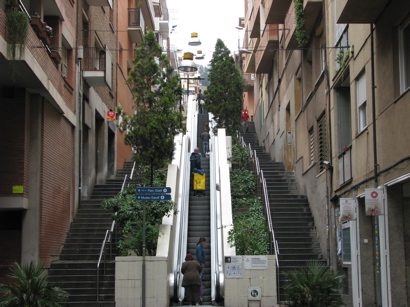
Going up
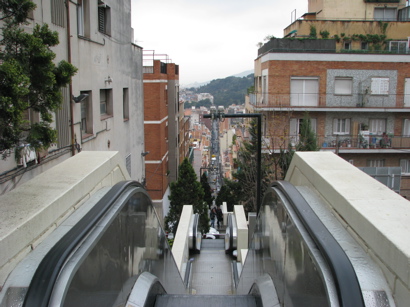
Looking down
—and were rewarded with excellent views of the city.
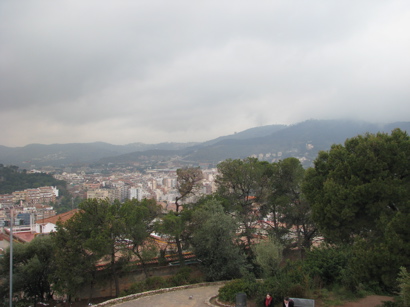
At the summit of the hill are stone steps leading up to three stone crosses.
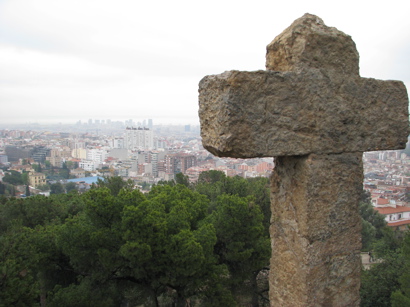
From this perch we could see the spires of La Sagrada Familia, and the green lanes of the avenue known as La Rambla leading down to the sea. It had begun to rain by this time, but only a drizzle. I had my pricey pink umbrella. Scott got wet.
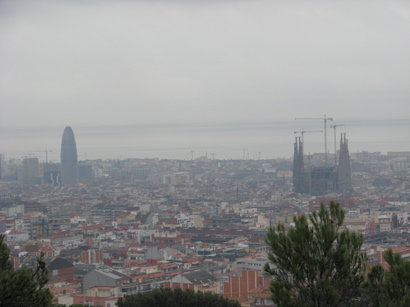
La Sagrada Familia on the right, and the building called Torre Agbar on the left
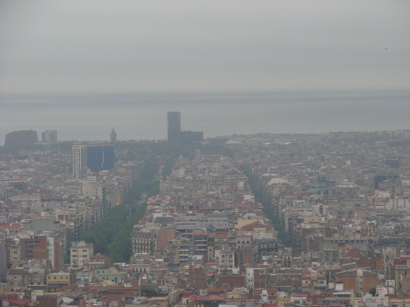
The wider green belt on the left is La Rambla, a pedestrian walkway lined with shops.
From far below us floated up the strains of trumpet music: the song selections amused me. Raindrops Are Falling on My Head, Singing in the Rain…I wondered if the musician was playing at a restaurant somewhere on the streets below.
Despite the rain, this was a beautiful place—but where was the Gaudi? After some uncertainty over which path to take, we tramped through dripping woods and down a dirt lane. A ripple of brightly colored mosaic railing told us we’d found the right place. The path took us to a wide, flat terrace with the undulating mosaic rail curving round.
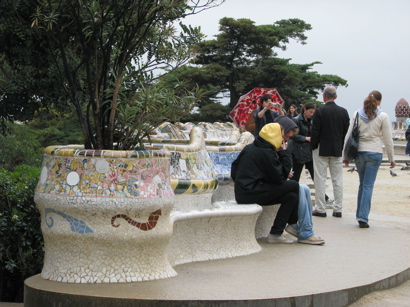
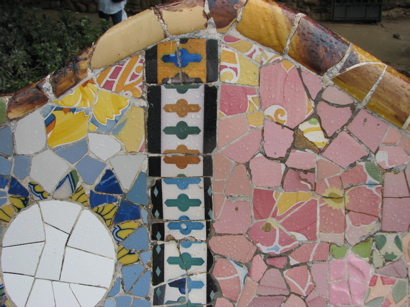
And there too we found the trumpet player: a busker leaning against the curved wall just out of the rain. I dropped a euro in his trumpet case, and he smiled wide and thanked me. He was from Cuba, he told us, and has a cousin in California. He’s been in Barcelona for six months. “Do you know the song I was playing?” he asked me, and I said, “No, but when I was up on the hill I heard you playing “Raindrops Are Falling on My Head,” and it made me smile.” He grinned broadly and said, “You knew!” Then he said he’d play a song just for us, a little Sinatra. It was “Fly Me to the Moon,” which I sing to my kids all the time. I laughed and clapped and he bobbed his trumpet up and down in reply, adding a little blast at the end to startle some children who were seeming a little too interested in his heap of change.
We walked to the edge of the terrace and looked down upon two buildings that were unmistakably Gaudi designs. A tall blue-and-white mosaic spire rose from a house right out of fairyland, or maybe candyland. Gaudi’s use of mosaic to ornament his structures is at once whimsical and breathtaking. (Scott, reading this, snorts: “Fairyland? More like Dr. Seuss on acid.”)
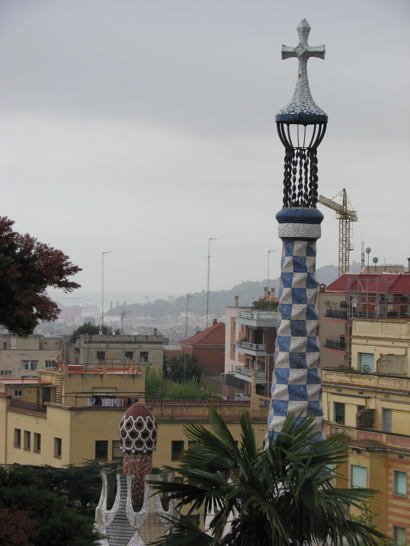
I wish the colors were true in these photos. The overcast day dulled the pictures, but even through the drizzle the real mosaics gleamed bright and vivid as jewels. Rich blues, greens, golds, crimsons…Everywhere we looked, we gasped. Every tiny detail is original and magical.
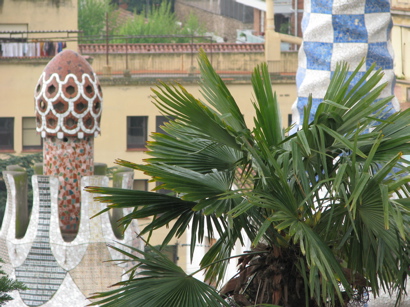
Scott thought the blue-and-white spire looked made of fabric.
Eventually we tore ourselves away from the view and followed some more steps down to a lower level, where we discovered we’d only just begun to see the wonders of Park Güell.
Below the terrace we were standing on is a…I don’t know what to call it. Domed area with many columns. The terrace forms its ceiling. That ceiling is like nothing else on earth. Concave circles side by side, like an Escher painting, circles done in mosaic. Most of them are a sort of iridescent tile, with here and there a dazzlingly bright ring of jewels.
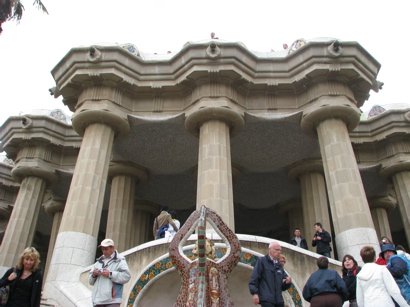



Another staircase leads down, presided over by my old friend the salamander.

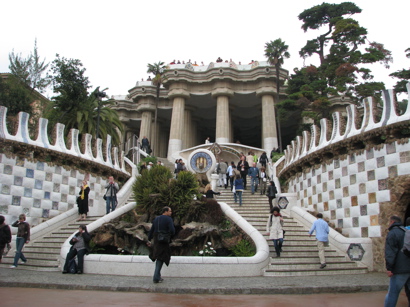
The main staircase. The big walls on either side are ornamented with the most beautiful tiles that have been broken and reassembled as mosaics in a repetition of the undulated surface used all over the park. Each colorful square has a concave shape, irresistible to the hands and soothing to the eyes.

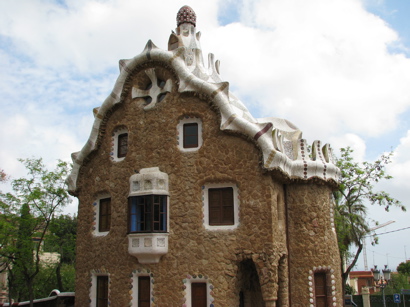
You can find much better pictures on Flickr and elsewhere. My camera batteries died partway through this visit, and the light was against me, so I didn’t get the perfect shots I wanted. But it’s a gorgeous place. It was intended to be a housing development of sorts, designed by Gaudi. The development never got off the ground, but later Gaudi bought one of the houses himself—not one of the ones in these pictures, which aren’t full-scale houses; there are two other buildings on the park grounds, designed by other architects, and it was one of these that Gaudi bought to live in with his elderly father. We toured it, but they didn’t allow photos. Not that it mattered for my camera at that point. I recharged them in the room, though, for the next day’s big outing: La Sagrada Familia.
More Park Güell pictures on Flickr
While Scott worked his evening portfolio review shift, I headed back up the many many steps to the Palau Nacional.
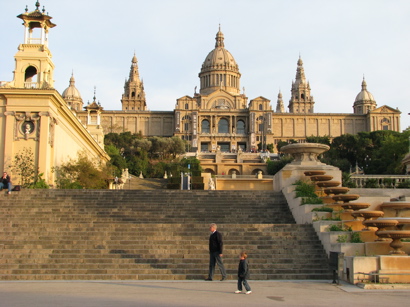
Don’t be fooled. These are only some of the steps.

The admissions clerk told me my ticket was valid for two days, which was a good thing because that first evening, I only had time to visit one floor. I began with the upper story, the modern art wings. This museum, the National Art Museum of Catalonia, is one of the best art museums I’ve ever visited.
The building is a work of art in its own right.

Ceiling.
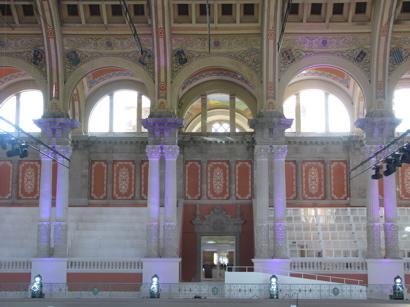
Auditorium.

Main gallery, looking up toward the dome.

Main gallery.
I wish I could post images of all the paintings and sculpture that blew me away. Artists new to me were Nicolau Raurich and Lluis Rigalt, both of whom had a way of painting luminous skies that reminded me of Maxfield Parrish.
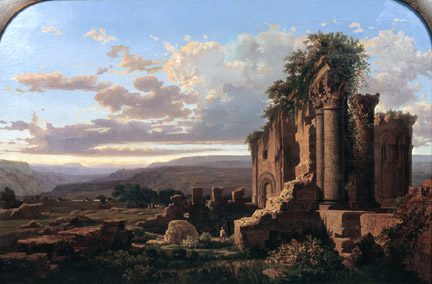
Ruins by Rigalt
I had heard of Fortuny and Joaquim Mir, but had never seen much of their work. Fortuny’s The Battle of Tetuan filled an entire wall and was overwhelming in its scope and detail. Hundreds of small stories are being played out there in the larger battle scene. I loved the wealth of detail in his Spanish Wedding, too. You can view images of these at the MNAC website, but the images (even when you click to enlarge) are too small to show off Fortuny’s genius.
There were a few small Picassos (I never did make it to the Picasso Museum, alas) and one Dali sketch. A larger Dali painting was on loan to another museum. I loved this sculpture by Llimona:
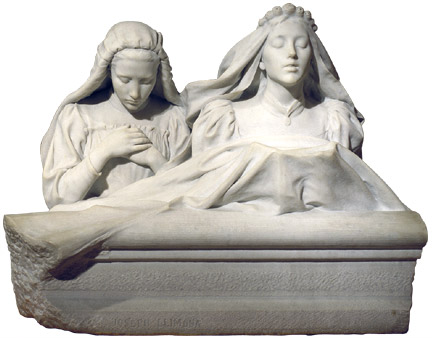
First Holy Communion
And this one by Claraso:
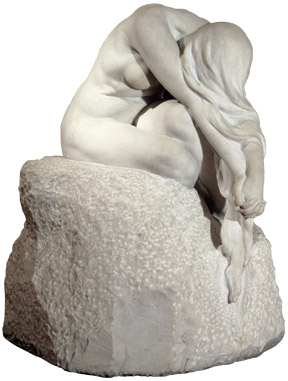
Eve
I knew my girls would love this dreamy painting by Joán Brull:
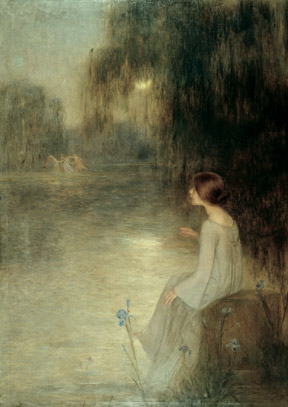
Reverie
Let me jump ahead now to Friday evening, when I returned for a few hours. This time I wandered through the rooms of religious art on the ground floor. Oh my goodness. Incredible sights to see there. Entire rooms are devoted to murals (or fragments of murals) recovered from old churches across Spain. These once vivid paintings are now faded and patchy, but you get a good sense of their majesty. The museum has replicated the size and shape of the interiors the murals once inhabited: room after room of domed ceilings and arched entrances. Hushed and full of shadows, these are solemn, contemplative spaces, illumined by scenes from the life of Christ in dusky blues and faded golds.
Other rooms contained ornate triptychs and gold-embellished paintings. The collections of Gothic and Romanesque religious art are world-famous, apparently. I can’t begin to do these collections justice, so I’m not even going to try. One image that I saw reprinted all over the place on postcards and book covers was the Christ figure from this twelfth-century altar frontal:
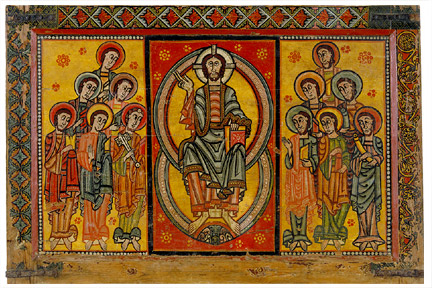
Apostles Frontal from La Seu d’Urgell
My favorite piece of religious art was this magnificent Counter-Reformation painting by Juan de Zurbarán.

Immaculate Conception
In the bookshop I bought a museum guide that contains images of almost everything in the museum, and it’s a good thing I did, because I’d have forgotten most of it already. I hope to track down prints of some of the paintings I loved, but I have to say a preliminary search has not yielded much fruit.
I tore myself away when the museum closed at seven. I knew Scott would be just getting off his shift at the con on the avenue down below. And now comes one of the most magical moments of the whole trip. I started down the first long flight of steps, marveling at how golden and beautiful the evening was and yet a bit wistful that there was an avenue of fountains ahead of me and all of them stilled. And just then, as the stairs took me past the highest fountain—it whooshed into life. Really. It was a waterfall, and as I traveled down the next few steps, the second tier of the waterfall burst over the ledge in a glittering spray. A few more steps, another waterfall—the awakening of the fountains keeping pace with my steps each time. It made me laugh out loud, it was so gorgeously serendipitious. It was like I was a Disney princess. I reached the broad flat level halfway down the hill, where the huge “Magic Fountain” fills the space. A small crowd had gathered round it and as I drew near, there was a sound like the intake of breath and then shhhh, up it came, the water arcing high above our heads from dozens of jets. And not just water, but music and lights. It opened with Clair de Lune, and I was not the only person there who got choked up.
But I didn’t have my camera with me. I know, I know. I had already been up Montjuic four times by this point and thought I’d snapped everything I could possibly snap. But here’s a YouTube clip from two years ago.
Magic fountain indeed.
I’ve been thinking through some things in emails (and offline) lately, and I wanted to bring some of those thoughts here. It has to do with patience, a good kind and a bad kind, and their relationship to happiness and learning, especially unschooling.
My children think I’m a pretty swell mom, but they know all too well that I have my faults. If you asked them, they would say (if they weren’t too loyal to rat on me) that my greatest fault is impatience. They’d be right, at least as far as my relationship with the kids is concerned. Impatience comes from frustration, (or does it lead to frustration?), and I think we all know that what spills over from an impatient person’s frustration is scolding, or nagging, or sharp words. Impatience is what you feel when people aren’t doing what you want them to do: it’s a frustrated desire for control.
When Jane was two years old, in the hospital fighting leukemia, people used to constantly compliment me for my patience. Other parents, nurses, doctors—I heard it from many people and it always puzzled me. I didn’t feel ‘patient,’ not in any virtuous sense. What I felt was a keen awareness that my days with this child might possibly be numbered, and I didn’t want to lose a single one of them to a bad mood. I wanted to savor every moment with my baby girl, in case I didn’t have many moments left to savor. So I gladly, gratefully, spent hours playing playdough with her, or giving her i.v. pole rides in the hallways, or holding her while she slept. You don’t need ‘patience’ to live through moments like that.
And through the years, I’ve held on to that sense of ‘savor this moment because it is precious’ with my kids. But I cannot deny that as the years passed, and as more children joined the party, impatience elbowed its way into my heart, my words, my actions. I can almost pinpoint the moment I changed, or at least the moment impatience boiled over into sharpness. Rose was three years old, and Beanie was a baby; we were at a lake beach near our home in Virginia, and I got stuck. Stuck trying to leave the beach, with an unhappy, sandy Bean crying on my hip and a bag slipping off my shoulder, and an intractible Rose straining to pull away from me, her heels digging into the wet sand, wavelets lapping at our ankles. We needed to leave. Jane was already halfway to the parking lot (and too young to be there alone). I couldn’t put the baby down without getting her wet (again), and I was out of diapers. Rose refused to budge. I felt helpless, completely held hostage by a stubborn toddler. I had to scoop her up under one arm like a football and carry her, screaming and squirming, back to the car.
I say “had to,” but I’m sure I had other options. It didn’t seem like it at the time. We were there with friends—the dad friend would, in later years, recall that episode with glee, the day he “saw Lissa lose it.” Why I didn’t holler to him to stop grinning and pick up Rose, I don’t remember. I am quite certain that either of the mom friends who were present would have been happy to help. They probably offered to, but what I remember about the moment is that sense of helplessness and frustration.
Moms of small children can run into that feeling often. What it is, really, is a feeling of being out of control. Loss of control is scary. I dealt with it well when the loss of control was due to illness, something out of any human being’s power to alter. But ah, it’s when a person, or people, especially small people who are “supposed” to obey their mama, are flouting my attempts to control—that‘s when impatience comes in.
People who try to control other people often find themselves feeling impatient, or worse. The reason mothers (to single out one kind of person) scold or fuss or nag or criticize their children is because they are trying to bring a situation back under control—that is, to make things go the way the mom wants them to go.
When I had three or four children each wanting to go a different direction, that’s when I got impatient. That’s when I became a mom who scolds. That’s when I stopped savoring every moment, only selected moments.
That’s when I started to wonder what had happened to the patient mommy I used to be. I used to be so patient—I would think that all the time, forgetting that in the days when people remarked upon my patience, I hadn’t felt like patience came into the equation at all.
I think when we talk about patience in terms of a quality we don’t feel like we possess (“I used to be so patient”), we are talking about a kind of patience that isn’t really a virtue at all. That kind of patience is about enduring the present moment until a better one comes along. It’s a gritting-one’s-teeth-and-getting-through-it state of mind.
It’s how many of us endured countless hours of our lives in school. The kids who didn’t patiently endure were the ones labeled troublemakers. Patient endurance is how most people get through hours in line at the DMV, or (to poke my own self here) the interminable waits in doctor’s offices. There is no moment-savoring going on in that kind of patience. In fact, often ‘being patient’ really just means ‘being quiet and not making a fuss’ while resentment or irritation is churning underneath.
I think the reason people tend to be less patient with their children is because they can in fact exert some external control over the children—as opposed to the doctors who keep us waiting, or the complicated beaucratic systems directing the flow of traffic at the DMV.
But “exerting control” by nagging, scolding, lecturing, ordering in a drill-sergeant’s bark—these are actions that, sooner or later, will do harm to a relationship. Nobody likes being nagged, scolded, or lectured ‘for their own good.’ I sure don’t like it, I know that much. It’s a complete violation of the Golden Rule, isn’t it? Treating children the way we’d like to be treated if we were in their shoes means finding other ways of dealing with those out-of-control moments.
I think for me, the shift back toward a better way began when I drove the kids from Virginia to California by myself. Rilla was six months old, Wonderboy three. Scott had already started his job out here, and he would have flown back to drive with us but I talked him out of it. If he came along, we’d be on the clock; he could only take so much time off work. If I drove alone, we could amble, stopping as often and as long as the kids needed to—which turned out to be very, very often. I had to abandon myself to the flow of the trip: letting go of the desire to control every move we made. We wound up having a wonderful time, the six of us, and I think a big part of the reason is because that 2700-mile journey was about taking each moment as it came. They were moments worth savoring, and savor them I did.
Not that there weren’t some bumps in the road. There were (are) still five children, not all of them always wanting the same thing. But I found that being mindful of the difference between ‘taking care of’ and ‘controlling’ (or trying to control), and being determined to appreciate the present moment, not just try to to ‘get through’ it—those attitudes eliminate impatience. Really. And then the bumps in the road become part of the grand adventure, challenges to be tackled, puzzles to be solved. It’s so much more satisfying to be creative and fun than to be frustrated and stern.
There is another kind of patience, a good kind. It’s the quality that allows a mother with ten places to put every minute to sit in the driveway drawing chalk figures for her toddler, or blow bubbles until the whole bottle is gone, or take half an hour to walk down the block, admiring every dandelion and ant that catches her little one’s eye. It’s the patience that plays a game of Monopoly with an eight-year-old until every last dollar is in someone’s pile, the kind that listens with interest to a detailed recounting of the latest phone-book-sized Teen Titans collection. That kind of patience isn’t about enduring the present moment until a better one comes along. It’s about enjoying the present moment for exactly what it is, with gusto and gratitude.
There’s “patience in suffering,” too, of course, and while perhaps that kind isn’t about enjoying the present (painful or sorrowful) moment, it too involves a willingness to accept the present moment for what it is. People who are patient in suffering tend to be people overflowing with gratitude for all the other things in their lives besides suffering. This is a very great virtue, and I think it grows out of the peaceful sense of appreciation for what is, now, as opposed to a longing for something different, something better: it’s the good kind of patience all grown up.
Anyway, I’ve been thinking about all this in conjunction with unschooling, which is a whole way of living that embraces the present moment, rejoices in what is good about it. Unschooling says: this day, this encounter, this connection of ideas, this moment between us—this is very, very good. Unschooling begins with a dismissal of the kind of experiences that a child must “patiently endure” in order to be “educated,” but it is more than that, more than a rejection of one way of being. Unschoolers see everything in the whole wide world as interesting, connected, something they can learn about. (Scroll halfway down at the link and you’ll see why I linked that page in particular, though the whole site speaks to the point.) Instead of patiently (or impatiently) enduring the long wait at the DMV, an unschooler might look around, notice things, think about them, wonder how and why. Why are all the people sitting in the back two rows in this waiting area, but are scattered among all the rows in that bank of seats over there? What kinds of jobs do the people waiting in line have, and was it hard for them to get time off to spend a weekday morning here? When did the old cameras get dumped in favor of digital cameras? Why are the walls a glaring white instead of something soft and soothing like in doctors’ offices? What is the ratio of DMV employees to customers? Is customer the right word for a person in line at the DMV?
Of course I’m not saying that unschoolers are the only people who approach life this way. Harvard professor John Stilgoe, the author of that book I’m still reading: he gets it. He sees what’s interesting in power lines and telephone poles and manhole covers. He has made these things interesting to me. Reading that book is making visible—even beautiful—all sorts of things that were ugly or invisible to me before. The other day I looked out my windshield sideways down a street and saw, for the first time in my life, how the rows of of drooping wires made a spiderweb against the sky: lacy, delicate, lovely.
It reminded me of Philip Isaacson’s book Round Buildings, Square Buildings, Buildings that Wiggle like a Fish, which showed me ways of looking at buildings that made every building interesting to me, made me see the artistry and story of the Brooklyn Bridge, the white clapboard church, the green glass skyscraper.
I’ll never forget reading, in college, Betty Edwards’s Drawing on the Right Side of the Brain, and how one of her students said that after taking Betty’s drawing class and working on portraits, every face she looked at seemed beautiful to her. The drawing lessons taught her to really look at people, and when she did, she saw beauty everywhere.
I know I’m going all over the place here, but in my mind these things are all connected: this way of really looking, really seeing, noticing what is interesting and important and even beautiful about things many people whisk by without noticing. And what I can do for my children is refuse to fill up their lives with things they must patiently endure until a better moment comes. I can savor the moments as they happen, and give them the time and space to find what’s interesting and beautiful in every face the world shows them.
As I was writing that last sentence, Beanie appeared in front of me with a big smile and a present: a bracelet made of safety pins linked together, each pin shining with green and blue beads. “It’s for you, Mommy,” she breathed, so proud and excited. “Jane showed me how.” How patiently (the good kind of patience) she must have worked to slide all those beads in place.
I never noticed before what a work of art a safety pin is!

"On the route to Aigle from Ollon, where we live in Switzerland, one passes an orchard. Neatly planted rows of trees are beautifully pruned and trained to form straight aisles for fruit-picking, with a grassy carpet beneath. But the thing which causes most passersby to turn and look, and look again, slowing up the car if they are driving, is the touch of an artist indeed. Planted at the end of every row of trees is a lovely rose bush, and in midsummer these bushes are a riot of color in a variety of roses. There is just one rose bush at the end of each line, but this is enough to lift the entire work, which could be merely efficient fruit-farming, into a work of art, enjoyed by hundreds who pass each day—bringing influence into lives as well as being a subject of discussion, and bringing about, in other gardens, results of which the ‘artist’ may never know."
—The Hidden Art of Homemaking by Edith Schaeffer

![]()
 I didn’t get my hands on Carol Kendall’s other books until I was older—gosh, much older, my archives tell me. I posted about The Gammage Cup in 2010, shortly after reading it for the first time. (Scott, when you see this, skip the blockquote—I know you prefer to encounter a new book with a totally blank slate. I’m probably starting Gammage as a readaloud today.)
I didn’t get my hands on Carol Kendall’s other books until I was older—gosh, much older, my archives tell me. I posted about The Gammage Cup in 2010, shortly after reading it for the first time. (Scott, when you see this, skip the blockquote—I know you prefer to encounter a new book with a totally blank slate. I’m probably starting Gammage as a readaloud today.)

 With teeth like that, who wouldn’t smile big?
With teeth like that, who wouldn’t smile big?






























